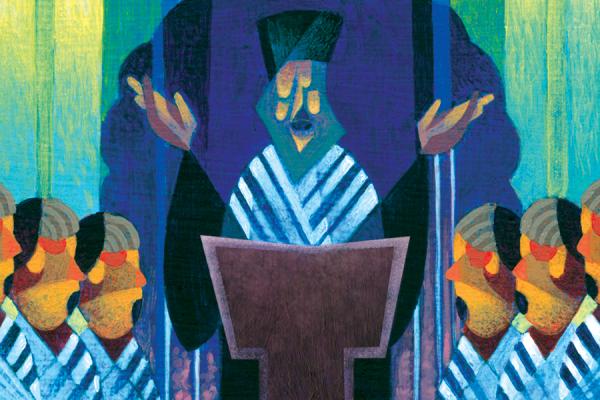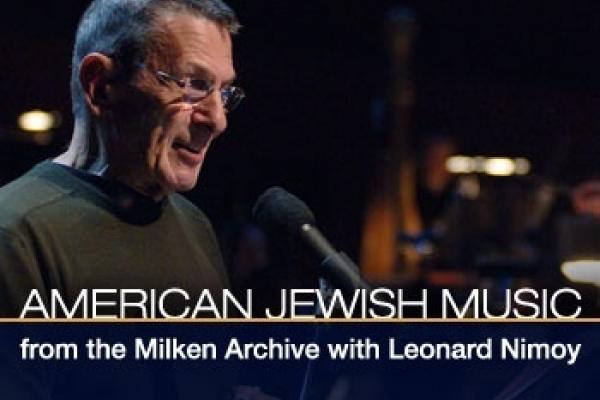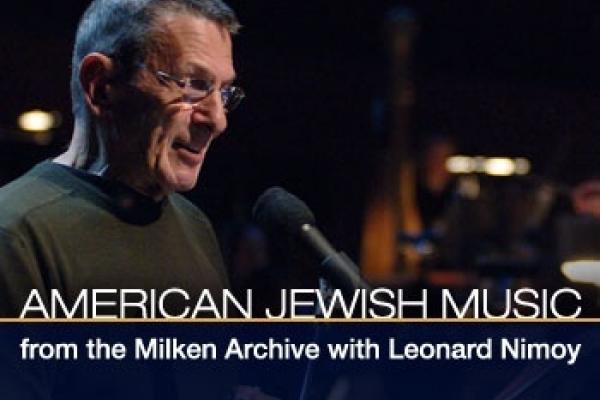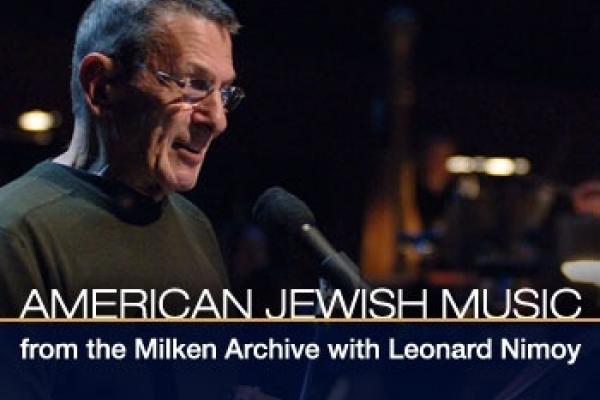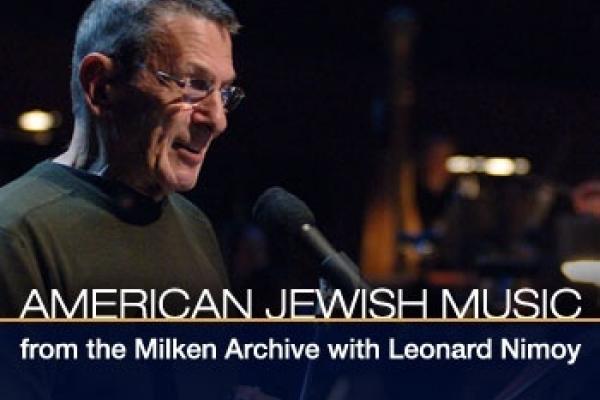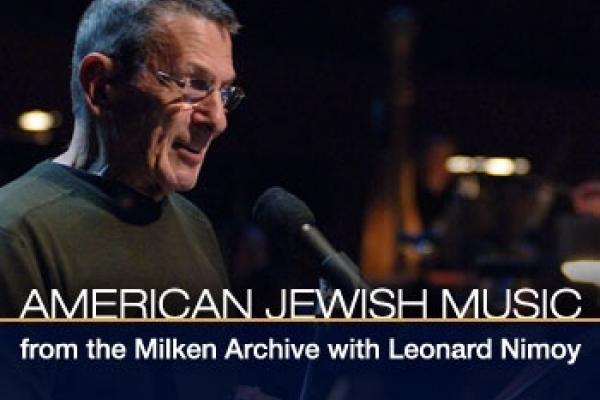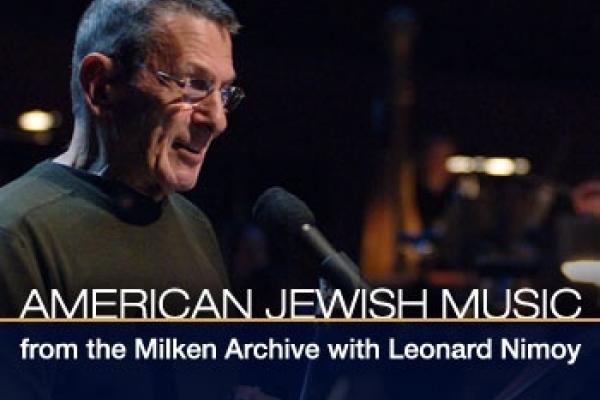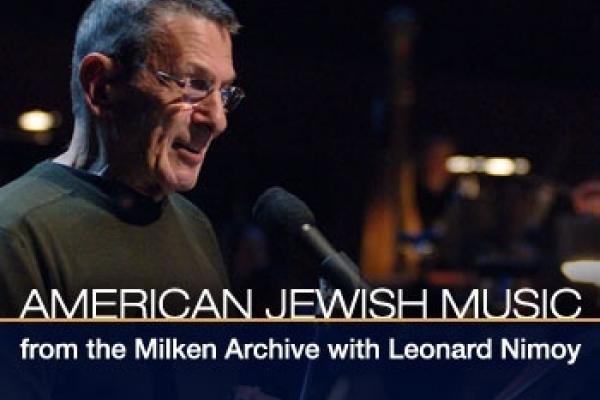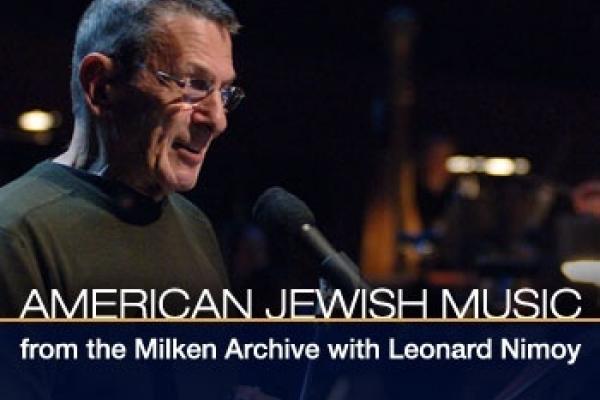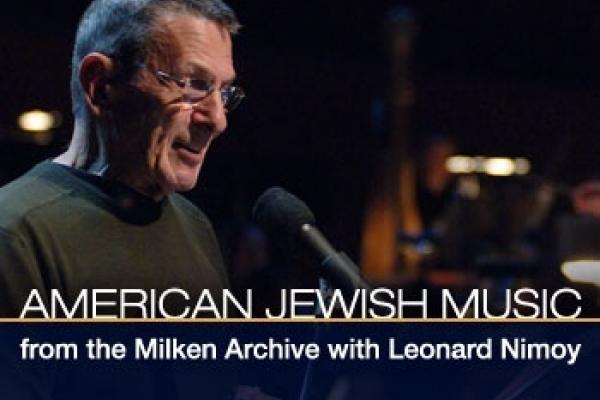Episode 2: Concertos
Click on the ![]() icon on the top-right of the video to access the full playlist.
icon on the top-right of the video to access the full playlist.
Instrumental concert music on Jewish themes is explored in the second episode of the series.
Episode Transcript
Leonard Nimoy
Beginning in the late 19th century, composers of music for the concert hall increasingly turned to their ethnic heritage for inspiration. Antonin Dvořák, the composer of the “New World” Symphony, drew deeply on his Czech heritage. Sir Charles Stanford composed an “Irish Symphony,” and Edvard Grieg arranged “Norwegian Dances.”
Leonard Nimoy
In America, a number of Jewish composers also created concert works inspired by their own culture. Hello, I’m Leonard Nimoy. Welcome to another program in a 13-part series that celebrates three and a half centuries of uninterrupted Jewish life in the United States through music, as documented by the Milken Archive of American Jewish Music and issued on CD on the Naxos label. On today’s program, music for solo instruments and orchestra by five very different composers who – in their own unique ways – created concert works of distinctly Jewish character.
Leonard Nimoy
In a recent conversation recorded for this program, conductor Gerard Schwarz and musicologist Neil Levin reflected on how an abstract form like a concerto might embody Jewish elements.
Gerard Schwarz
When we deal with vocal music, especially if it's liturgical and if it's in Hebrew, the Jewish connection, of course, is very obvious. When we deal with even symphonic music, there generally can actually be a story or a tone poem. With a concerto, it seems to me anyway that it's a little more remote. And yet on our program today, these six concertos have a very definite relationship to what we call the American Jewish experience. What do you think, Neil?
Neil Levin
If we look at the entire spectrum of Jewish history, vocal music is the primary medium of expression, just as it is in Western music, really up until Mozart. In Judaism history, of course, it's much, much more recent. The idea of Jewish art music, that's something very, very manifestly American begun in St. Petersburg in the first part of the 20th century. I think the element that connects all of these concerti is the use of Judaic musical material from genuine tradition. I emphasize genuine tradition, not only European, but from near Eastern traditions and so forth. And throughout these works, the soloist becomes a virtuoso interpreter of these various traditions. We selected these concerti because they make use of genuine folk melange, rather than invented artificial things that people perceive as folk. And in fact, they're really just recent pop things. And that was really the mission of many of these composers, to ferret out that which was genuine in the folk melange. And that can be religious. In other words, synagogue music, the way we chant the Bible is a folk tradition, that is to say its oral transmission or secular folks, such as a lullaby among Yiddish speaking Jewry in a small town in Poland and so forth.
Neil Levin
So all of these concerti make use of some part of genuine Jewish folk melange.
Leonard Nimoy
The opening work on this program, from the Milken Archive of American Jewish Music, is the first concerto by the composer and violinist Joseph Achron.
Gerard Schwarz
The fascinating thing about Achron, of course, is that he himself was a great violin virtuoso. Having studied with Leopold Auer, a matter of fact, when Elmar Oliveira, who's the soloist on this performance, recorded the work, he told me that he was just absolutely knocked out with the incredible beauty, but also the fireworks and the great understanding of the violin that Achron had.
Neil Levin
Well, of course, Achron is known to all violinists for one piece, the Hebrew melody. The Hebrew melody. The Hebrew melody is the only piece that he wrote in most people's minds, including great violinists.
Gerard Schwarz
What's interesting about that, Neil, is that most people don't even know who wrote Hebrew melody. They just know that was the Heifetz: Encore that he did so often.
Neil Levin
When Achron wrote the Hebrew melody, that was before he came to America. He was very young and he was, throughout his life, both in his own perception of a virtuoso violinist and a composer, as well as an avid writer on Jewish musical esthetics. He wrote three violin concertos in the United States. The first one he dedicated to Heifetz, whom he came to know very well because as a matter of fact, his brother, Isidore, was Heifetz's accomplice for many years. Heifetz was a champion of Achron's music. The first violin concerto is the only one of the three that is not only manifestly Judaism in its use of material, but it is detailed in its incorporation of Jewish folk, melange, religious, and secular. The first movement begins with an exposition of the traditional Ashkenazi, that is European, Hebrew chant for the Book of Lamentations, which is done annually on Tisha B'Av, on the ninth of the Month of Av, which is the commemoration of the destruction of both the first and the second temple. This is a fast day. The chant, which goes back at least to the Middle Ages, is the same one that Leonard Bernstein used in the Jeremiah Symphony.
Neil Levin
The only thing is that Achron thought of it decades earlier, and he created this virtuoso violin piece out of that, plus other synagogue melodies and synagogue chants that had been part of tradition for hundreds and hundreds of years into the first movement. The second movement, he uses Yemenite folk tunes.
Gerard Schwarz
In the early part of the 20th century, he was a member in St. Petersburg of this group that fostered Jewish folk music.
Neil Levin
It's called the Society, or it was called the Society for Jewish Folk Music in St. Petersburg, and then it had branches in several other cities in the Russian Empire. But its mission was really to create a Jewish art music. It's called Society for Jewish Folk Music because the governmental authorities refused to issue a charter to them unless they used the word folk. In fact, the governor general is said to have said, Look, I don't know what you mean by Jewish music. You want to call it that? We can't give you a charter. You don't have Bach or Beethoven or anything like that. But if you call it folk music, I've heard some Jewish folk music and it's fascinating. So basically, this group said, Look, what's the difference what the name is? Anyway, their mission was to do what people like Dvorak and Smetana and so forth were doing to address nationalism in music by turning to the folk music of the Jewish people throughout Europe and using it to create an art music. Achron was intent on that. He was interested in that his whole life.
Leonard Nimoy
Neil W. Levin, artistic director of the Milken Archive, spoke with Gerard Swarts. Here now is violinist Elmar Oliveira with the Berlin Radio Symphony Orchestra under the direction of Joseph Silverstein to perform the Violin Concerto No. 1, opus 60 of Joseph Achron.
Violin Concerto No. 1 by Joseph Achron
Leonard Nimoy
That was the first violin concerto by Joseph Achron, composed in 1925. Its first movement quotes a traditional Ashkenazi chant for the Book of Lamentations, along with other references to traditional liturgical chants and tunes; the second is a set of variations on two Yemenite Jewish folk tunes. In this Naxos recording, made for the Milken Archive of American Jewish Music, Joseph Silverstein led the Berlin Radio Symphony Orchestra, and the soloist was Elmar Oliveira.
Leonard Nimoy
You’re listening to a program of concertos inspired by Jewish themes, on this series from the Milken Archive. I’m Leonard Nimoy. The second work we’ll hear has a literary inspiration, as Gerard Schwarz discusses with Neil Levin.
Gerard Schwarz
Joel Hoffman wrote a wonderful work called Self Portrait for cello and orchestra that his brother Gary plays on this recording. It certainly has a very Yiddish flavor. Can you give us a little background to this one?
Neil Levin
Well, the full name of the work is Self Portrait with Gebirtig. Mordechai Gebirtig was a very important Jewish poet who was eventually murdered by the Germans in the Holocaust. He is probably best known for one of his poems called Es Brent, It's Burning, talking about a village burning in a pogrom. And when Joel Hoffman wrote this piece, and I think he wrote it, didn't he, for his brother to play? He did. He wrote it for Gary. He had become interested in Gebirtig's life and in Gebirtig's poetry. And he tried to capture the surrounding world of the Yiddish literature in that part of the world.
Leonard Nimoy
Joel Hoffman, the composer of this next work, is a native of Vancouver, British Columbia, and is professor of composition at the University of Cincinnati's College Conservatory of Music. His brother, Gary Hoffman, is the cellist in this performance of A Self Portrait with Gebirtig. Christopher Wilkins conducts the Berlin Radio Symphony Orchestra.
Self-Portrait with Gebirtig by Joel Hoffman
Leonard Nimoy
“Self-Portrait with Gebirtig,” an evocation of the Yiddish poet Mordechai Gebirtig – music by Joel Hoffman, in a performance by his brother, cellist Gary Hoffman, soloist with the Berlin Radio Symphony Orchestra led by Christopher Wilkins.
Leonard Nimoy
Our program of concertos associated with Jewish themes continues with a work for viola and orchestra. Conductor Gerard Schwarz talks with Neil Levin about its composer.
Gerard Schwarz
One of the most gifted composers writing today is Paul Schoenfield. He thinks of himself as a folk musician. I remember when I commissioned him to write a work for the Seattle Symphony, he said, I don't write big symphonic works. I don't write tone poems. I'm Richard Strauss. I write folk music. I assimilate music that is close to me in my background, in my world, and I make it into a piece. I said, But I see you as this seamless craftsman who's able to incorporate the remarkable music that means so much to you, folk music, hassidic music, Klezmer music, whatever it may be, and you make it into something that is very much your own language. I hear a piece of Paul's and I think of it as being clearly singular in the fact that it couldn't be written by anyone else. It's an extraordinary gift that he has. This viola concerto, I think, does that impeccably well.
Neil Levin
Look, I think he's overly modest, and I think it's very genuine on top of everything else because there is a lot of false modesty around. But he's too good a craftsman to just pick things up on the one hand automatically. On the other hand, I don't think you can attribute any of his, what you refer to as master craftsmanship, and it absolutely is, to any tutelage. I'd like to agree with you on yet another point, which is that I long ago noticed, even before this project, that I could pretty much tell it was a piece of Schoenfield if I heard it, because where else could one hear that craftsmanship, especially in symphonic works that reflect so transparently, so much authentically traditional Jewish material.
Leonard Nimoy
Neil Levin, speaking with Gerard Schwarz, a member of the Editorial Board of the Milken Archive.
Leonard Nimoy
Let’s listen now to the Viola Concerto of Paul Schoenfield. Its first movement alludes to the songs sung in a kindergarten in Israel where the children came from traditional religious homes. The second movement, called Soliloquy, is a prayer-like meditation. The virtuoso finale, King David Dancing Before the Ark, refers to an incident in the Biblical book of Second Samuel. Here is violist Robert Vernon -- longtime friend of the composer, principal violist of the Cleveland Orchestra, and the musician for whom this concerto was written – performing with the Berlin Radio Symphony Orchestra and conductor Yoel Levi, in a Naxos Paul Schoenfield’s Viola Concerto of 1998.
Concerto for Viola and Orchestra by Paul Schoenfield
Leonard Nimoy
The Concerto for Viola and Orchestra by Paul Schoenfield, composed in 1997 and 1998, and played here by the violist for whom it was composed, Robert Vernon. Yoel Levi directed the Berlin Radio Symphony Orchestra. This world premiere, Naxos Release, was recorded by the Milken Archive of American Jewish Music. I'm Leonard Nimoy. In just a moment, we'll return to this program of concertos from the Milken Archive with two World Premiere recordings. This is the WFMT Radio Network.
Leonard Nimoy
Welcome back to this program in a series from the Milken Archive of American Jewish Music. I’m Leonard Nimoy. This week we’re listening to music for solo instruments and orchestra.
Leonard Nimoy
Lowell Milken, who founded the Milken Archive in 1990, spoke to us recently about the impact of the project in the years to come.
Lowell Milken
It's been extremely gratifying and humbling to see one's vision become a reality. But I recognize that I am really only a small part of this greater community that has created the Milken Archive. I will say, however, that I see the archive as perhaps the most historic project that we've ever created at the Milken Family Foundation. We are actively involved in trying to find cures for cancer, and certainly if we're successful, I would rate that as one of the great achievements of our time. But I see the archive having a growing impact and having a great relevance 50, 100, 200 years from today. As it continues to educate and to enrich the lives. And that's one of the reasons why the archive is expressed in my mind as a living project. It's really as much about the future as it is about the past.
Leonard Nimoy
Lowell Milken, Chairman of the Milken Family Foundation. Our next selection is a bit of a novelty. It’s a Fantasy for Violin and Orchestra, written by a composer best known for his voluminous popular Yiddish theater songs – especially for one hit song. His name is Sholom Secunda.
Gerard Schwarz
Bay mir bistu sheyn. Everybody knows this song. It's a wonderful song. But did Secunda write other things besides Bay mir bistu sheyn?
Neil Levin
Very late in his life, Secunda wrote one of a few very serious pieces. This was an oratorial cantata type thing. It's claimed that afterwards he said, I hope this piece will make people forget that I'm the composer of Bay mir bistu sheyn. The funny thing about Bay mir bistu sheyn, and we could talk about that for two hours and we wouldn't be finished, is that to this day, it's a known song, even among young people in Europe. I tested it out when we were recording in Germany. They don't even know that it was originally a Yiddish song, let alone Secunda, because they know it's been translated into dozens of languages. In fact, it was being played on the radio in Germany after the National Socialists took power during the Nazi era because they didn't know it was by a Jew, let alone that it was originally in Yiddish.
Gerard Schwarz
Do you think that the popular music that he was known for and that he composed so wonderfully is reflected now in this violin concerto?
Neil Levin
He tried not to reflect that because remember, no matter what we do, Sholom Secunda was one of the four big names, the Big Four of Second Avenue, the popular mass entertainment known as, Second Avenue Yiddish Theater. And Bay mir bistu sheyn was simply a song from a show which had 12 or 14 other songs. Secunda wrote dozens and dozens and dozens of songs better than that for the Yiddish Theater, and that was his main fame and his main thrust. Now, he always claimed that he wanted to be so called classical composer, but it's very difficult for us to know to what extent he really would have pushed a button and eliminated the theatrical part, even though he claimed otherwise. This piece, which is really a fantasy for violin and orchestra, is a curiosity. I discovered it among Secunda's memorabilia. This piece was never published. Nobody knew about this. What interested me was that he was incorporating elements of religious material as opposed to his Yiddish theater music. He was incorporating synagogue chant in this piece and other synagogue melodies. So he was trying not to be a theater composer in this piece.
Leonard Nimoy
Neil Levin, Artistic Director of the Milken Archive of American Jewish Music, talking with conductor Gerard Schwarz about composer Sholom Secunda, and his concerto for violin and orchestra. Here is that one-movement work, from a Naxos CD recorded by the Milken Archive, with Gerard Schwarz conducting the Berlin Radio Symphony Orchestra. The soloist is Elmar Oliveira.
Fantasy in C Minor for Violin and Orchestra by Sholom Secunda
Leonard Nimoy
A concerto for violin and orchestra by the composer of the hit song “Bay mir bistu sheyn”: Sholom Secunda. Elmar Oliveira was the soloist in this world-premiere Milken Archive recording on the Naxos label, with the Berlin Radio Symphony Orchestra under the direction of Gerard Schwarz.
Leonard Nimoy
This program from the Milken Archive concludes with another premiere recording of a concerto inspired by the Jewish experience – a piano concerto by Jacob Weinberg. Milken Archive Artistic Director Neil Levin talks about its Jewish connections.
Neil Levin
This piece is easy to elicit the Jewish connection by playing it to audiences who are familiar with synagogue melodies that are in use today, as well as with other secular things. Jacob Weinberg comes from the same group in Russia as Achron from the Society for Jewish Folk Music. And then he went to Palestine, like many of those composers did. Some stayed, some came to the United States. So he's another one like Achron who came to the United States. He, therefore, was also imbued with the idea of creating a Jewish art music, a genuine Western music, in other words, out of folk, melange, both religious and secular. In so far as anybody knows now, he wrote two piano concertos, but the other one is just a good piano concerto. This one incorporates in one movement a melody that every Ashkenazi Jew in the world has heard since at least the Middle Ages on Yom Kippur, the holiest day of the year. This particular melody has to do with the reenactment of the priestley ceremony that occurs only on Yom Kippur called the Avodah. He uses this melody, but he creates a virtuoso pianistic piece around it. The other movement is written to a secular Jewish tune, one of the most popular, most famous tunes of the second or third Aliyah era in what was then Palestine, one of what we call the Hebrew, Palestinian folk songs, whether they were folk or not, but they became folk songs.
Neil Levin
It's called Artza Alinu, we're going up to our land. And that's the theme upon which he creates a whole movement. So it's a fascinating juxtaposition.
Leonard Nimoy
Neil Levin. Jacob Weinberg, a pianist as well as a composer, was born in Odessa and became a Zionist early on. He left for Palestine in 1921, and then came to New York in 1926, where he composed a number of liturgical works as well as concert pieces. His Piano Concerto No. 2 in C Major is played in this Naxos release from the Milken Archive by Jorge Federico Osorio. Karl-Anton Rickenbacher leads the Barcelona Symphony/National Orchestra of Catalonia.
Piano Concerto no. 2 in C Major by Jacob Weinberg
Leonard Nimoy
A piano concerto by Jacob Weinberg, who lived from 1879 to 1956. Karl-Anton Rickenbacher conducted the Barcelona Symphony/National Orchestra of Catalonia, with pianist Jorge Federico Osorio, in a Milken Archive recording released on the Naxos label.
Leonard Nimoy
You’ve been listening to another program in a 13-part series devoted to the recordings of the Milken Archive of American Jewish Music, currently being issued on CD by the Naxos label. The Milken Archive was created by Lowell Milken, chairman of the Milken Family Foundation. Neil W. Levin is Artistic Director.
Featured Speakers
 Lowell Milken |  Neil Levin |  Gerard Schwarz |
|---|
Featured Tracks
| Joseph Achron: Violin Concerto no. 1 |
| Joel Hoffman: Self-Portrait with Gebirtig |
| Paul Schoenfield: Concerto for Viola and Orchestra |
| Sholom Secunda: Violin Fantasy in C minor, “Nusha'ot” |
| Jacob Weinberg: Piano Concerto no. 2 in C major |
About the Series
| Produced in conjunction with the WFMT network and broadcast on radio stations throughout the U.S., American Jewish Music from the Milken Archive with Leonard Nimoy is a 13-part series of two-hour programs featuring highlights from the Milken Archive’s extensive collection of the musical recordings. Episodes include interviews and commentary with Lowell Milken, Neil W. Levin, and Gerard Schwarz. Radio stations interested in broadcasting the series should contact media@milkenarchive.org. |
Date: November 08, 2022
Credit: Milken Family Foundation
